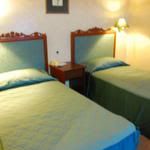 Arrival
Arrival
It’s almost ten o’clock and I’m typing this in the lobby of my hotel, Queen Margarette, in the city of Lucena. This is our first stop on our six-day tour of Quezon province and I’m so glad the hotel has WiFi (although it doesn’t extend into my room).
My room is a comfy “Superior” with two twin beds and cable TV. The room’s highlight is the tub in the bathroom. Yes, a TUB! The only drawback is no bubble bath mix, but it’s OK. At least I can get a soak to soothe my not-so-weary muscles.
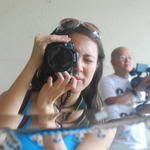 I spent most of today lugging around my sister’s Nikon D-80 DSLR camera. She taught me how to use the shutter speed, f-stop, and ISO settings last night, and I have been experimenting with them. There’s nothing quite like getting one’s hands “dirty” (so to speak) when learning a new skill.
I spent most of today lugging around my sister’s Nikon D-80 DSLR camera. She taught me how to use the shutter speed, f-stop, and ISO settings last night, and I have been experimenting with them. There’s nothing quite like getting one’s hands “dirty” (so to speak) when learning a new skill.
My favorite thing to do is turn up the aperture settings so the camera exposes a little longer. This gives a little more brightness to my photos. The places that are a dank and musty in actuality acquire a more cheerful tone.
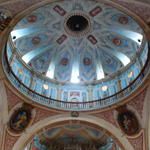
sunlight shining through Tayabas Church’s domed ceiling

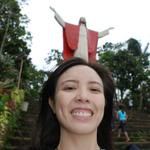
I also spent most of the day in my new and very first pair of Converse Chucks (the hi-cut kind, too). This trip is going to involve hikes, and these shoes came in handy when it was time to climb the 200-plus (or 300-plus, depending on which side you ascend) steps up the Kamay ni Hesus site in Lucban.
Now if only I could figure out a way to see what I’m photographing behind me when I turn the camera on myself…
Rain, Rain, Go Away
I was up before the crack of dawn (4:30am to be exact) and we soon were on our way to the heritage houses of Sariaya.


Sights at Sariaya Church
The day was overcast so everything took on a grayish tone, but I managed to find the white balance setting on “Olsen” (Marielle’s D-80) and was able to take some shots of the Marquez ancestral house. It hasn’t been lived in for a while, and it definitely shows — but what an interesting subject that made it.



Marquez ancestral house in Sariaya
I also found the black-and-white setting on the camera, which was perfect for capturing the dark disappointment I felt when I had to rush back to our van to avoid getting pelted by the drizzle that cut short our shoot of the houses. But when the rain clouds lifted, so did our mood.


the obligatory vanity shots
My favorite part of the day happened in the evening, as our hosts at the Kinabuhayan Bed & Breakfast served us a gourmet dinner with meaty conversation on the side, both courtesy of production designer-turned-resident chef Jay Herrera. The B&B, according to Jay, has a rustic, earthy, unpretentious feel to it, and I agree. There’s also a sort of bohemian wildness to the place: even though it is well-tended, plants are allowed a little bit of overgrowth and their animals (dogs, pig, chickens) have the run of the place. It’s like Sonia’s Garden, but a little smaller and less tamed.




Dinner at the Kinabuhayan Bed & Breakfast
Jay would have liked us to stay, and I would have allowed him to talk my head off, but we had already made arrangements to check in at the Silangang Nayon resort. Situated in Pagbilao, Silangang Nayon would be the perfect jump-off point for our destinations on Day 3: the Quezon National Forest Park, Pinagbanderahan, and the second-largest mangrove plantation in the world.
She’ll Be Comin’ ‘Round the Mountain
“If a tree falls in the forest and no one can hear it, does it make a sound?”
For me, the thought became, “If I fall in the forest and no one can hear me, does it mean I’m done for?”
About 45 minutes before that came into my head, I had just started out on the two-kilometer trail up Mount Pinagbanderahan (elevation 1,600 feet above sea level). The cemented footpath was rising but level, and there were hand rails on each side. I thought, “Easy as pie!”
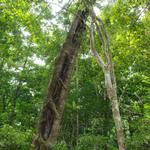
a tree in a forest in Atimonan
But soon the footpath disappeared entirely, and we had to follow our guides up and down the slope using roots and rocks as footholds, and vines as handholds. It probably was like following mountain goats: our guides were nimble and quick on their feet while I felt heavy and clumsy. Soon, I was sweating as if I had just taught two hours of BODYJAM.
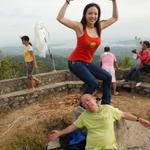
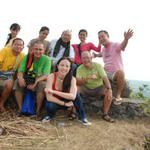
Victory! We made it! (barely)
Setting foot at the peak, however, enabled us to see a 360-degree view of Quezon, from the waters of Tayabas Bay in the South China Sea all the way to Lamon Bay in the Pacific Ocean (Quezon is on the isthmus separating the two bodies of water). We also saw the strange limestone mountains of which Pinagbanderahan is only one.

limestone mountains
Pinagbanderahan is in Atimonan, but within the boundaries of the Quezon National Park. As we headed down to lower elevations we passed through the Eme (letter M), a set of hairpin curves down the mountains.
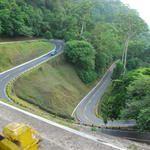
Eme Road, Quezon National Forest Park
That’s probably the last time in a while i’ll be heading for that peak, but what an experience. I kind of regret saying the following words to myself: “why do you climb the mountain? Because it’s there. Why do you come down from the mountain? Because there’s nothing there.”
There was something there. We were there.
The Island
Quezon is a massive province, stretching across the eastern coast of Luzon. It also encompasses the island of Polillo in the Pacific Ocean — and that was our final destination in Quezon.
To get to Polillo from mainland Quezon, we had to take a boat from the port of Real. The funny thing about the road system is that to get from the southern part (where the cities of Lucena and Lucban are) to the northern part (where Real is), we had to leave Quezon and pass through the neighboring province of Laguna.
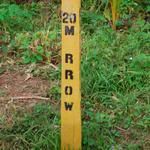
I thought it said “Tomorrow”
From Real it’s a long boat ride to Polillo: about an hour and 45 minutes long. We docked at the port of Polillo, and from then on it was a crazy cowboy adventure off the beaten track, not all of it happy or pleasant.
The photos and video we took were beautiful, but oh what we went through for just one shot.
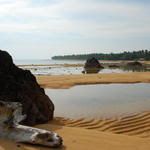

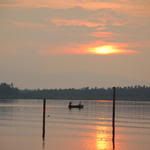
We make this look easy.
I still can’t talk about it in detail because a lot of it is unbloggable (and quite frankly, traumatic), but just to give you a taste of what I went through…
My crew and I were sent to film an island off the southern tip of Polillo, called Balesin. In its heyday, it was a private members-only resort with a white sand beach said to rival that of Boracay.

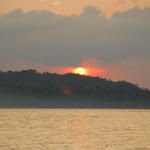

shots from the boat to Balesin
Unfortunately its heyday was back in the 1960’s — but nobody had bothered to inform Quezon’s tourism office. So, we were expecting something magnificent, only to come upon decrepit cottages, overgrown golf course, and a debris-strewn beach that were just unsuitable for filming.
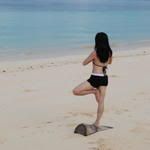
a Tree got washed up on the shore
The worst part about it was the 8-hour round trip boat ride, where I had to be in a boat with 11 men. I was the only woman. So even though it was nearing midday on the ride back, I sat on the roof of the cabin just to get away from all those men.
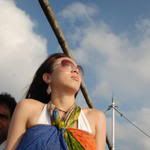
I sunbathed on the roof.
By the way, while we were in Polillo, the island came under red alert because the New People’s Army were supposedly about to invade the island. Even worse, the NPA already knew there were some media people (us) on the island. I had fears that what happened to Ces Drilon might happen to us, even though we’re not exactly mainstream big media and the NPA don’t hold people for ransom — they just demand a “revolutionary tax”.
Anyway, we came out unharmed and have some pretty nice pictures. There were also some lighthearted moments among my crew, and I guess that’s what pulled us through: our camaraderie, and willingness just to laugh things off.
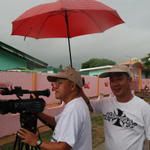
the brothers from another mother: videographer Oying and driver Japs
But next time I go to Quezon, I’ll probably stick to the paths well-traveled. Polillo needs a bit more developing before I return.

 Follow
Follow